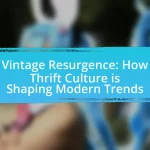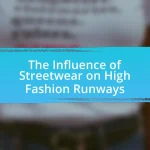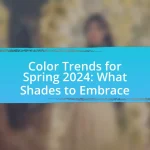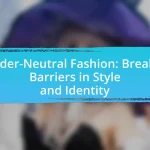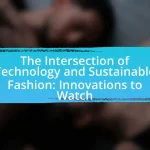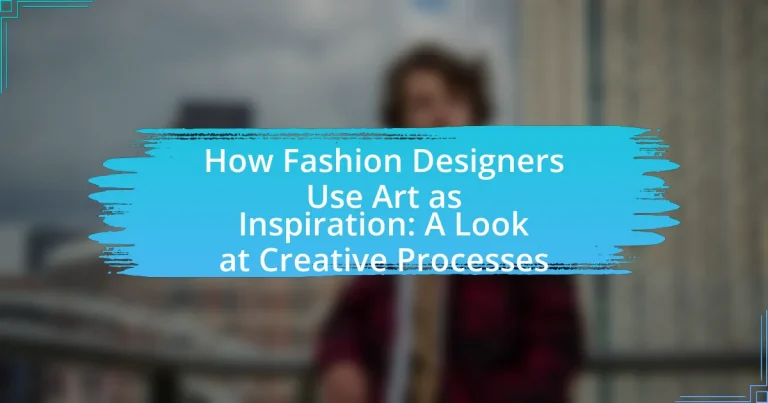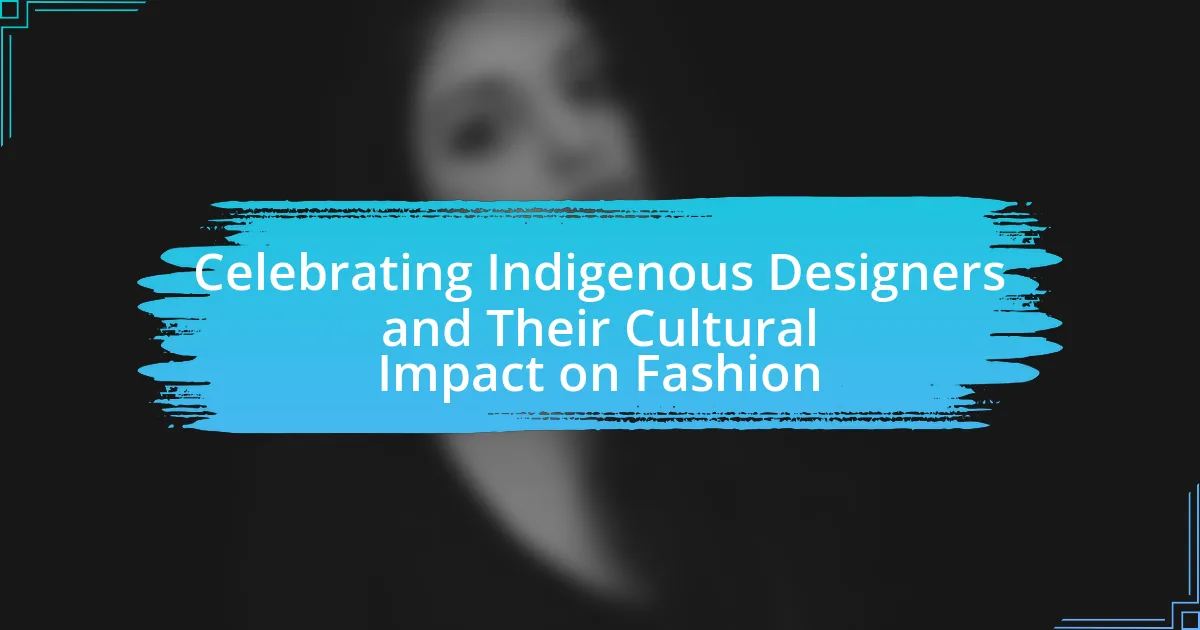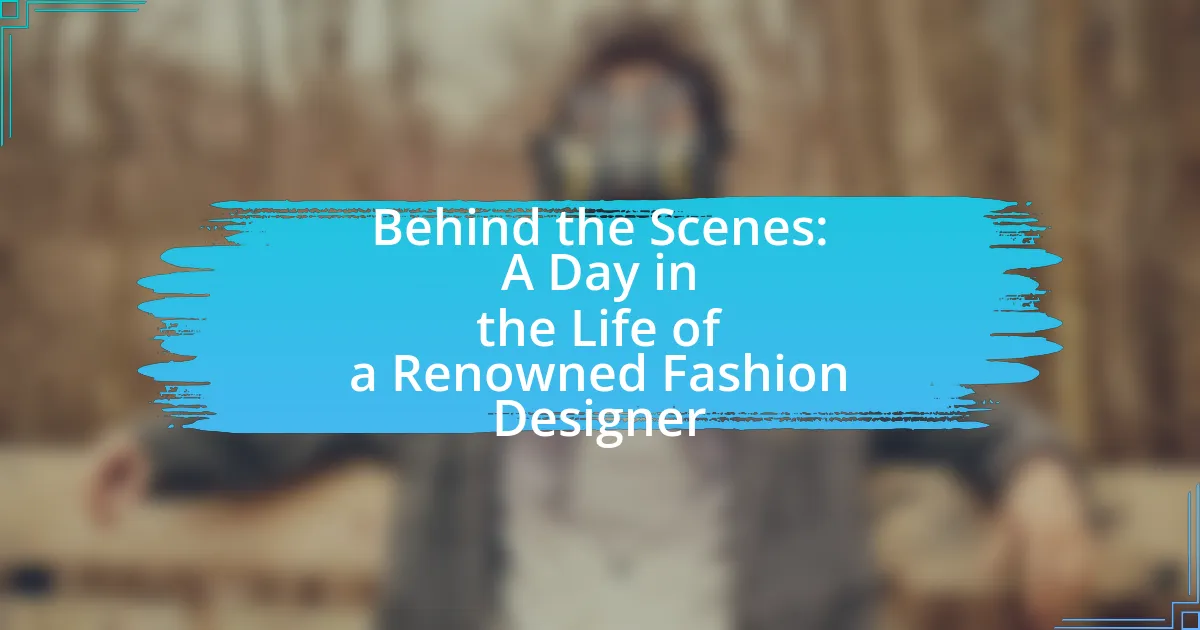Fashion designers draw inspiration from art by interpreting visual elements, themes, and techniques from various artistic movements, such as Impressionism and Fauvism, to create unique garments. The article explores how different types of art, including visual, performing, and decorative arts, influence fashion design, highlighting historical connections and contemporary collaborations between designers and artists. It discusses the creative processes employed by designers, the challenges they face, and the importance of balancing originality with artistic influence. Additionally, it provides practical tips for emerging designers on utilizing art in their collections and developing a personal style influenced by artistic movements.
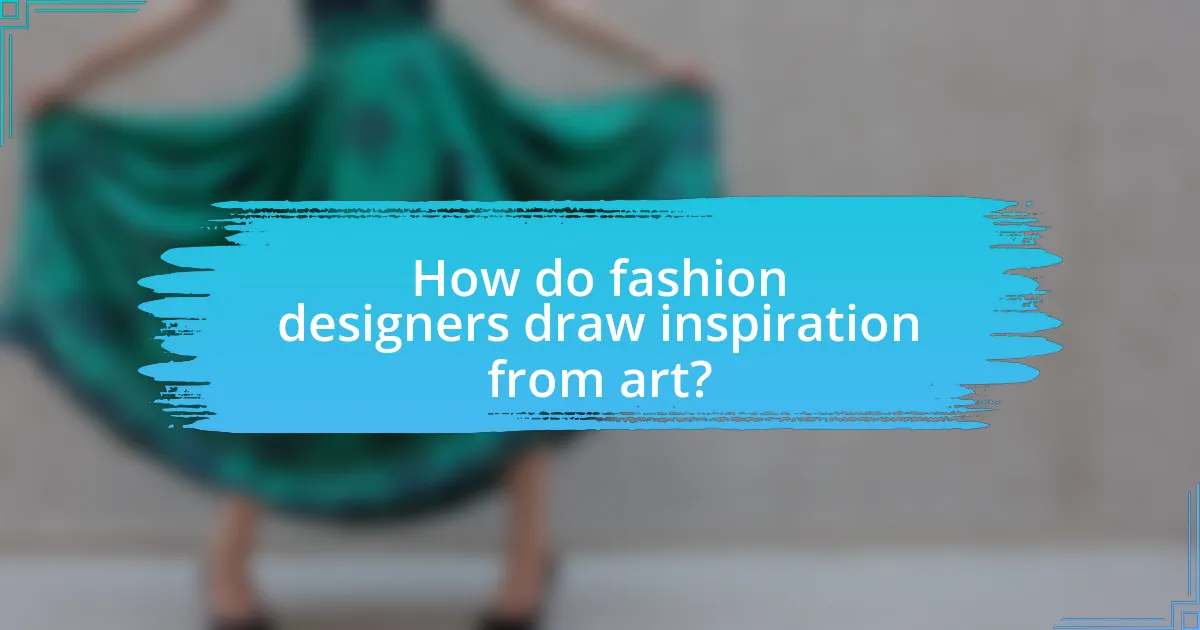
How do fashion designers draw inspiration from art?
Fashion designers draw inspiration from art by interpreting visual elements, themes, and techniques found in various artistic movements. For instance, designers often reference the color palettes, textures, and forms present in paintings, sculptures, and installations to create unique garments. Historical examples include the influence of Impressionism on the fluidity of fabrics and the bold colors of Fauvism shaping vibrant collections. Additionally, contemporary designers frequently collaborate with artists, merging fashion with fine art to produce innovative pieces that reflect both disciplines. This cross-pollination not only enriches the fashion narrative but also elevates the status of clothing as a form of artistic expression.
What types of art influence fashion design?
Various types of art influence fashion design, including visual arts, performing arts, and decorative arts. Visual arts such as painting, sculpture, and photography provide color palettes, textures, and themes that designers incorporate into their collections. For instance, the Impressionist movement has inspired numerous fashion designers through its emphasis on light and color, leading to collections that reflect similar aesthetics. Performing arts, particularly theater and dance, influence fashion through costume design, which often dictates trends in everyday wear. Additionally, decorative arts, including ceramics and textiles, contribute patterns and craftsmanship techniques that are essential in fashion design. Historical examples include the influence of Art Deco on 1920s fashion, characterized by geometric shapes and luxurious materials, showcasing how art movements directly shape fashion trends.
How do visual arts impact fashion collections?
Visual arts significantly influence fashion collections by providing inspiration for design elements, color palettes, and thematic concepts. Designers often draw from various art movements, such as Impressionism or Surrealism, to create garments that reflect artistic styles and philosophies. For instance, the collaboration between fashion designer Yves Saint Laurent and artist Piet Mondrian in the 1960s resulted in iconic dresses that mirrored Mondrian’s geometric compositions, showcasing how visual arts can directly shape fashion aesthetics. This interplay between visual arts and fashion not only enhances creativity but also allows for cultural commentary and emotional expression within collections.
What role does performance art play in fashion inspiration?
Performance art significantly influences fashion inspiration by providing dynamic expressions of identity, culture, and emotion that designers can translate into wearable art. This form of art often challenges traditional aesthetics and societal norms, prompting designers to explore innovative silhouettes, textures, and narratives in their collections. For instance, designers like Alexander McQueen and Jean-Paul Gaultier have drawn from performance art to create theatrical runway shows that blur the lines between fashion and art, showcasing garments that tell a story or evoke a specific feeling. The integration of performance art into fashion not only enhances visual appeal but also encourages deeper engagement with the audience, making the clothing a part of a larger artistic dialogue.
Why is art considered a vital source of creativity for designers?
Art is considered a vital source of creativity for designers because it provides a rich reservoir of visual language, concepts, and emotional resonance that can inspire innovative ideas. Designers often draw from various art forms, such as painting, sculpture, and photography, to explore color theory, composition, and texture, which are essential elements in their work. For instance, the use of bold colors and abstract forms in modern art has influenced fashion designers like Yves Saint Laurent, who famously incorporated art into his collections, demonstrating how artistic movements can shape design aesthetics. This interplay between art and design fosters originality and encourages designers to push boundaries, ultimately leading to unique and compelling creations.
How does art evoke emotional responses in fashion design?
Art evokes emotional responses in fashion design by utilizing visual elements, color theory, and thematic narratives that resonate with human experiences. Fashion designers often draw inspiration from various art forms, such as painting, sculpture, and photography, to create garments that convey specific moods or messages. For instance, the use of vibrant colors can evoke feelings of joy or excitement, while muted tones may elicit calmness or nostalgia. Historical examples include the influence of Impressionism on designers like Christian Dior, who incorporated soft pastels and flowing silhouettes that mirrored the emotional essence of the art movement. Additionally, fashion collections often tell stories or reflect cultural themes, further enhancing the emotional connection between the viewer and the design. This interplay between art and fashion not only shapes aesthetic appeal but also fosters a deeper emotional engagement with the audience.
What historical connections exist between art movements and fashion trends?
Art movements and fashion trends have historically influenced each other, with notable connections evident in various periods. For instance, the Impressionist movement in the late 19th century inspired fashion designers to adopt softer colors and flowing silhouettes, reflecting the movement’s emphasis on light and natural forms. Additionally, the Art Deco movement of the 1920s brought geometric patterns and luxurious materials into fashion, mirroring the architectural and artistic styles of the time. The Surrealist movement also impacted fashion, as designers like Elsa Schiaparelli incorporated dreamlike imagery and unconventional designs, challenging traditional aesthetics. These examples illustrate how art movements have shaped fashion trends by introducing new concepts, styles, and materials, creating a dynamic interplay between the two fields throughout history.
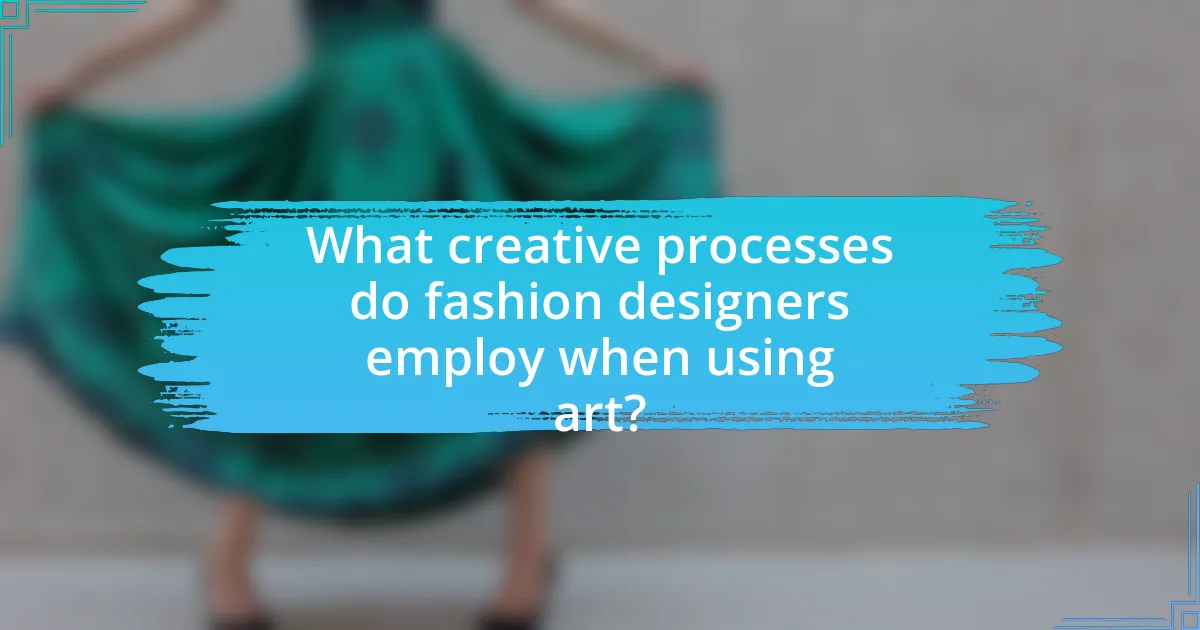
What creative processes do fashion designers employ when using art?
Fashion designers employ various creative processes when using art, including research, conceptualization, and experimentation. Designers often begin by researching different art movements, artists, and styles to gather inspiration, which informs their design direction. For example, the influence of Impressionism can lead to the use of color palettes and brushstroke techniques in fabric patterns.
Next, designers conceptualize their ideas by sketching and creating mood boards that visually represent their artistic inspirations. This step allows them to explore how art can translate into wearable fashion. Additionally, experimentation with materials and techniques, such as draping or digital printing, enables designers to merge artistic elements with practical garment construction.
These processes are validated by the fact that many successful fashion collections have drawn directly from art, such as Yves Saint Laurent’s “Mondrian” collection, which showcased the direct influence of Piet Mondrian’s geometric paintings on fashion design.
How do designers incorporate artistic elements into their work?
Designers incorporate artistic elements into their work by integrating visual aesthetics, color theory, and cultural references into their designs. This process often involves studying various art movements and techniques, allowing designers to draw inspiration from paintings, sculptures, and other forms of art. For instance, the use of bold colors and abstract patterns can be traced back to movements like Impressionism or Cubism, which influence contemporary fashion collections. Additionally, designers may collaborate with artists or utilize artistic motifs in textiles, thereby merging fine art with wearable design. This approach not only enhances the visual appeal of their creations but also connects fashion to broader cultural narratives, as seen in collections inspired by famous artists like Frida Kahlo or Andy Warhol.
What techniques do designers use to translate art into fashion?
Designers use techniques such as color theory, pattern adaptation, and material experimentation to translate art into fashion. Color theory allows designers to select palettes that evoke the emotions and themes present in artworks, while pattern adaptation involves reinterpreting visual motifs from paintings or sculptures into textile designs. Material experimentation enables designers to explore textures and forms that reflect the essence of the original art piece. For instance, the collaboration between fashion designer Alexander McQueen and artist Damien Hirst showcased how McQueen utilized Hirst’s iconic butterfly motifs in his collections, effectively merging visual art with wearable fashion.
How do mood boards and sketches reflect artistic inspiration?
Mood boards and sketches serve as visual representations of artistic inspiration by compiling images, colors, textures, and concepts that resonate with a designer’s creative vision. These tools allow designers to explore and communicate their ideas effectively, providing a tangible reference that encapsulates the emotions and themes they wish to convey in their work. For instance, a mood board might include photographs of nature, fabric swatches, and color palettes that evoke a specific atmosphere, while sketches translate these inspirations into preliminary designs. Research indicates that visual stimuli significantly influence creativity, as demonstrated in studies showing that exposure to diverse artistic elements can enhance innovative thinking in design processes.
What challenges do designers face when using art as inspiration?
Designers face several challenges when using art as inspiration, primarily including the risk of plagiarism, the difficulty of translating artistic concepts into wearable designs, and the potential disconnect between artistic intent and consumer appeal. Plagiarism concerns arise when designers draw too closely from existing artworks, leading to legal and ethical issues. Translating artistic concepts into fashion requires a deep understanding of materials and construction techniques, which can be complex and time-consuming. Additionally, there is often a gap between the avant-garde nature of art and the practical needs of consumers, making it challenging for designers to create pieces that resonate with the market while staying true to their artistic vision.
How do designers balance originality with artistic influence?
Designers balance originality with artistic influence by integrating personal creativity with established artistic styles. This process involves analyzing existing art forms and trends while infusing their unique perspectives and innovations. For instance, designers often study historical art movements, such as Impressionism or Surrealism, to draw inspiration while ensuring their designs reflect contemporary themes or personal narratives. This dual approach allows designers to create work that resonates with audiences and maintains relevance in the fashion industry, as seen in collections that reinterpret classic art pieces into modern wearable designs.
What are common pitfalls in interpreting art for fashion?
Common pitfalls in interpreting art for fashion include oversimplification, cultural appropriation, and lack of context. Oversimplification occurs when designers reduce complex artistic concepts to mere aesthetic elements, losing the original meaning and depth of the artwork. Cultural appropriation happens when fashion designers borrow elements from cultures without understanding or respecting their significance, leading to controversy and backlash. Lack of context refers to the failure to consider the historical and social background of the art, which can result in misinterpretation and a disconnect between the fashion piece and its artistic inspiration. These pitfalls can undermine the integrity of both the art and the fashion created from it.
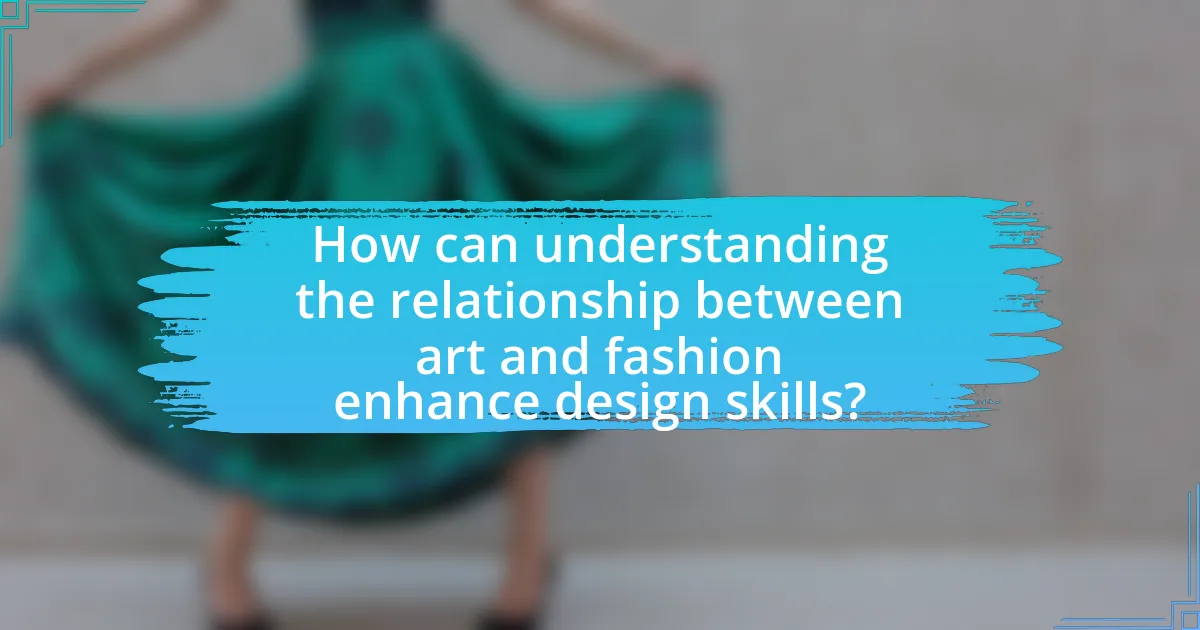
How can understanding the relationship between art and fashion enhance design skills?
Understanding the relationship between art and fashion enhances design skills by fostering creativity and innovation in the design process. When designers study art movements, they gain insights into color theory, composition, and cultural context, which can inform their fashion creations. For instance, the Impressionist movement’s use of light and color has influenced numerous fashion collections, allowing designers to experiment with textures and hues in their garments. This cross-pollination of ideas not only broadens a designer’s aesthetic vocabulary but also encourages them to think outside conventional fashion norms, leading to unique and compelling designs.
What practical tips can designers use to find artistic inspiration?
Designers can find artistic inspiration by exploring diverse sources such as nature, art galleries, and cultural events. Engaging with nature allows designers to observe color palettes, textures, and forms that can influence their work. Visiting art galleries exposes them to various artistic styles and techniques, fostering creativity. Additionally, attending cultural events, such as festivals or exhibitions, provides insights into different cultural aesthetics and trends. Research indicates that exposure to varied stimuli enhances creative thinking, as noted in the study “The Role of Diverse Experiences in Creative Thinking” by Smith and Jones, published in the Journal of Creative Behavior.
How can visiting galleries and museums influence a designer’s work?
Visiting galleries and museums can significantly influence a designer’s work by exposing them to diverse artistic styles, historical contexts, and innovative concepts. This exposure allows designers to draw inspiration from various art forms, which can lead to the development of unique design elements and creative solutions. For instance, the integration of color palettes, textures, and patterns observed in artworks can directly inform a designer’s collections. Research indicates that designers who engage with art institutions often report enhanced creativity and a broader understanding of cultural narratives, which can be pivotal in shaping their design philosophy and aesthetic direction.
What role does collaboration with artists play in fashion design?
Collaboration with artists plays a crucial role in fashion design by infusing creativity and innovation into the design process. This partnership allows fashion designers to draw inspiration from various artistic styles and techniques, resulting in unique and visually compelling collections. For instance, collaborations between fashion brands and contemporary artists, such as the partnership between Louis Vuitton and Takashi Murakami, have led to iconic pieces that blend high fashion with fine art, enhancing brand visibility and cultural relevance. Such collaborations not only elevate the aesthetic appeal of fashion items but also create a dialogue between different forms of art, enriching the overall fashion narrative.
How can emerging designers effectively utilize art in their collections?
Emerging designers can effectively utilize art in their collections by integrating artistic elements that resonate with their brand identity and target audience. This can be achieved through collaborations with visual artists, incorporating unique prints and patterns inspired by contemporary art movements, or using art as a narrative tool to convey themes and emotions within their designs. For instance, designers like Alexander McQueen have successfully drawn from art history, using techniques such as digital printing to create garments that reflect artistic styles, thereby enhancing the storytelling aspect of their collections. This approach not only differentiates their work in a competitive market but also engages consumers on a deeper emotional level, as art often evokes personal connections and interpretations.
What resources are available for designers seeking artistic inspiration?
Designers seeking artistic inspiration can utilize a variety of resources, including art galleries, museums, online platforms, and design blogs. Art galleries and museums provide direct exposure to historical and contemporary artworks, which can spark creativity and new ideas. Online platforms like Pinterest and Behance offer vast collections of visual content, allowing designers to explore diverse styles and trends. Additionally, design blogs often feature interviews with artists and designers, showcasing their creative processes and providing insights that can inspire new projects. These resources collectively enhance a designer’s ability to draw inspiration from various artistic expressions.
How can designers develop a personal style influenced by art?
Designers can develop a personal style influenced by art by immersing themselves in various artistic movements and techniques, allowing them to draw inspiration from the aesthetics and philosophies of those works. Engaging with art history, visiting galleries, and studying the works of influential artists can provide designers with a rich palette of ideas and concepts to incorporate into their designs. For instance, the use of color theory from Impressionism or the bold patterns of Abstract Expressionism can inform a designer’s choices in fabric and silhouette. This approach is validated by the fact that many successful designers, such as Yves Saint Laurent and Alexander McQueen, have openly cited specific artists and art movements as pivotal influences in their creative processes, demonstrating the tangible impact of art on fashion design.
